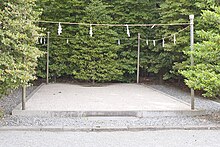User:Ansei/Sandbox-Soshitsu
| This is a Wikimedia global user page. If you find this page on any site other than a Wikimedia one, you are viewing a mirror site. Be aware that the page may be outdated, and that the user whom this page is about may have no personal affiliation with the site. The original page is located at https://meta.wikimedia.org/wiki/User:Ansei/Sandbox-Soshitsu. |  |

This draft text is under construction.
迷惑です。-- en:WP:Wikibullying + en:WP:Witchhunt
Why?
edit1. In the 1st "Big Weekend" project, I participated because I was asked to do it -- no other reason. Afterwards, I tried to pull my thoughts together about what worked? and why? The process was a catalyst which caused a more important insight -- that (a) others might not be asking themselves similar questions; and (b) the likely responses to these kinds of open-ended questions were likely to be different and varied. For example, the articles about people who had died in 2011 caused me to begin to think again about what is missing from articles about the shoguns and samurai of the Edo period. Do you see what I mean?
2. In the 2nd and 3rd "Big Weekend" projects, the subjects were a bit outside the range of things I normally write about. The exercise was an experiment with how my conventional patterns and habits of research in the pre-Meiji history of Japan might be adapted to work with modern subjects. In the process of parsing similarities and differences, my thinking moved slowly towards a fresh perspective. For example, the pigeonhole patterns of List of airports in Japan caused me to re-think the development of articles which grow out of The Fifty-three Stations of the Tōkaidō and List of the 53 Stations of the Tōkaidō. In other words, I used to think that the Tōkaidō "stations" were articles about artworks and/or about places (and, of course, this is still valid). At the same time, it's a little different -- and better -- to recognize that, in addition, these are also 16th century transport "hubs" which grew and changed over time.in ways that are possibly similar to Airline hubs In specific, my understanding of what is needed in articles about villages, towns and cities of Japan was too much influenced by the Japanese Local Autonomy Law (地方自治法 Chihō-jichi-hō) of 1947? In other words, the "Big Weekend" served as a kind of refresher or development seminar which helped me to see ways that my contributions to our wiki-project could be better. Do you see what I mean?
3. In the 4th-8th "Big Weekend" projects, I began to take notice of the ways in which the weekend was a unique opportunity to work with unfamiliar colleagues. There was a demonstrable difference in the way collaborative work developed. I wasn't able to categorize and explain the difference, but I did recognize that the difference was important. For example, I noticed that the way in which others approached the Big Weekend topic was recognizable across a span of months. The experience suggested a new perspective on process of consensus-building, but I couldn't quite put my finger on what had changed in my point-of-view. Do you see what I mean?
- Big Artillery Weekend (BARW)?
- Big Bridge Weekend (BBW)?
- World Heritage Sites & National Parks (BWH)?
- Big Red Link Weekend (BWR)?
- Big Olympic Weekend (BOW)?
- Big Space Weekend (BSW)?
Separately and independently, I continued to wonder how "Is the glass half empty or half full?" could be the cause of a "slugfest" here. At the same time, I wondered why there was no response to my questions about what we've learned or not learned? It took me a year to see the obvious correlation.
Now I see that the too-often repeated "slugfest" scenario is not the same as bullying. At WP talk:Big Weekend, when Macdonald-ross explains that "we see deep-seated differences emerge", his words are a deliberately vague diplomatic euphemism. On one hand, we can see that I did almost understand what happened, but I continued to struggle for the next 8 months. I was trying to figure out (a) how this became controversial; and (b) what could have been done to avoid or avert controversy?
In my efforts to avoid Wikipedia:Administrators' noticeboard#Bullying, I studied what others had written at en:Bullying -- especially one sentence added in 2010 at en:Bullying#Of typical bystanders:
For me, this sentence was a little bit misleading -- not wrong, but obscuring something else that is important and subtle. Yes, the cited sources cited support the use of the word "friends" ..., but that's not all there is to it.
There is also something else which I learned from the Big Weekends. Friends aren't only a source of personal encouragement. Working with others on Big Weekend articles also help to create a slightly wider perspective.
For emphasis, this needs to be made bold: This point-of-view is outside the scope of what the bully does to define and control issues, relationships and context.
In the past year, the only part of SEWP which did not have a bully at the center of everything was the Big Weekends. I still can't put it into words well enough, but this small non-bullying context created a fulcrum or a lever or a small place to stand .... That has made a big difference.
What?
editThe Ipse dixit of a bully vs. cited sources?
- en:Ryōta Tsuzuki → simple:Talk:Ryōta Tsuzuki#Move page (Ryōta Tsuzuki→Ryota Tsuzuki)
- en:Yūzō Tashiro → simple:Talk:Yūzō Tashiro#Move page (Yūzō Tashiro→Yuzo Tashiro)
- en:Ryūji Bando → simple:Talk:Ryūji Bando#Move page (Ryūji Bando→Ryuji Bando)
- en:Kōji Nakata → simple:Talk:Kōji Nakata#Move page (Kōji Nakata→Koji Nakata)
- en:Hokkaido region
- en:Shikoku region
- en:Kyushu region → simple:Wikipedia:Requests for deletion/Requests/2012/Kyūshū region